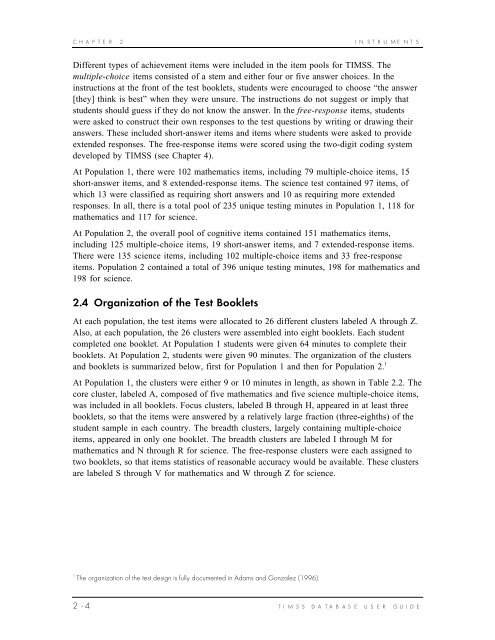User Guide for the TIMSS International Database.pdf - TIMSS and ...
User Guide for the TIMSS International Database.pdf - TIMSS and ...
User Guide for the TIMSS International Database.pdf - TIMSS and ...
You also want an ePaper? Increase the reach of your titles
YUMPU automatically turns print PDFs into web optimized ePapers that Google loves.
C H A P T E R 2 I N S T R U M E N T S<br />
Different types of achievement items were included in <strong>the</strong> item pools <strong>for</strong> <strong>TIMSS</strong>. The<br />
multiple-choice items consisted of a stem <strong>and</strong> ei<strong>the</strong>r four or five answer choices. In <strong>the</strong><br />
instructions at <strong>the</strong> front of <strong>the</strong> test booklets, students were encouraged to choose “<strong>the</strong> answer<br />
[<strong>the</strong>y] think is best” when <strong>the</strong>y were unsure. The instructions do not suggest or imply that<br />
students should guess if <strong>the</strong>y do not know <strong>the</strong> answer. In <strong>the</strong> free-response items, students<br />
were asked to construct <strong>the</strong>ir own responses to <strong>the</strong> test questions by writing or drawing <strong>the</strong>ir<br />
answers. These included short-answer items <strong>and</strong> items where students were asked to provide<br />
extended responses. The free-response items were scored using <strong>the</strong> two-digit coding system<br />
developed by <strong>TIMSS</strong> (see Chapter 4).<br />
At Population 1, <strong>the</strong>re were 102 ma<strong>the</strong>matics items, including 79 multiple-choice items, 15<br />
short-answer items, <strong>and</strong> 8 extended-response items. The science test contained 97 items, of<br />
which 13 were classified as requiring short answers <strong>and</strong> 10 as requiring more extended<br />
responses. In all, <strong>the</strong>re is a total pool of 235 unique testing minutes in Population 1, 118 <strong>for</strong><br />
ma<strong>the</strong>matics <strong>and</strong> 117 <strong>for</strong> science.<br />
At Population 2, <strong>the</strong> overall pool of cognitive items contained 151 ma<strong>the</strong>matics items,<br />
including 125 multiple-choice items, 19 short-answer items, <strong>and</strong> 7 extended-response items.<br />
There were 135 science items, including 102 multiple-choice items <strong>and</strong> 33 free-response<br />
items. Population 2 contained a total of 396 unique testing minutes, 198 <strong>for</strong> ma<strong>the</strong>matics <strong>and</strong><br />
198 <strong>for</strong> science.<br />
2.4 Organization of <strong>the</strong> Test Booklets<br />
At each population, <strong>the</strong> test items were allocated to 26 different clusters labeled A through Z.<br />
Also, at each population, <strong>the</strong> 26 clusters were assembled into eight booklets. Each student<br />
completed one booklet. At Population 1 students were given 64 minutes to complete <strong>the</strong>ir<br />
booklets. At Population 2, students were given 90 minutes. The organization of <strong>the</strong> clusters<br />
<strong>and</strong> booklets is summarized below, first <strong>for</strong> Population 1 <strong>and</strong> <strong>the</strong>n <strong>for</strong> Population 2. 1<br />
At Population 1, <strong>the</strong> clusters were ei<strong>the</strong>r 9 or 10 minutes in length, as shown in Table 2.2. The<br />
core cluster, labeled A, composed of five ma<strong>the</strong>matics <strong>and</strong> five science multiple-choice items,<br />
was included in all booklets. Focus clusters, labeled B through H, appeared in at least three<br />
booklets, so that <strong>the</strong> items were answered by a relatively large fraction (three-eighths) of <strong>the</strong><br />
student sample in each country. The breadth clusters, largely containing multiple-choice<br />
items, appeared in only one booklet. The breadth clusters are labeled I through M <strong>for</strong><br />
ma<strong>the</strong>matics <strong>and</strong> N through R <strong>for</strong> science. The free-response clusters were each assigned to<br />
two booklets, so that items statistics of reasonable accuracy would be available. These clusters<br />
are labeled S through V <strong>for</strong> ma<strong>the</strong>matics <strong>and</strong> W through Z <strong>for</strong> science.<br />
1 The organization of <strong>the</strong> test design is fully documented in Adams <strong>and</strong> Gonzalez (1996).<br />
2 - 4 T I M S S D A T A B A S E U S E R G U I D E

















